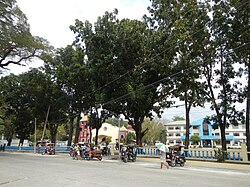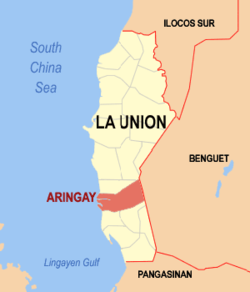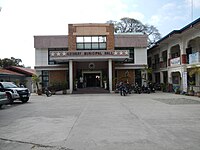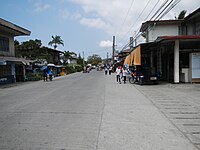Aringay
This article needs additional citations for verification. (August 2013) |
Aringay | ||
|---|---|---|
| Municipality of Aringay | ||
 Aringay town center along the National Highway | ||
 Map of La Union with Aringay highlighted | ||
Location within the Philippines | ||
| Coordinates: 16°23′54″N 120°21′20″E / 16.398208°N 120.355481°E | ||
| Country | Philippines | |
| Region | Ilocos Region | |
| Province | La Union | |
| District | 2nd district | |
Founded | 1641 | |
| Barangays | 24
(see Vice Mayor Benjamin O. Sibuma | |
| • Representative | Sandra Y. Eriguel | |
| • Municipal Council | Members | |
| • ZIP code | 2503 | |
| PSGC | ||
| IDD : area code | +63 (0)72 | |
| Native languages | Ilocano Pangasinan Tagalog | |
| Website | www | |
Aringay , officially the Municipality of Aringay (
Known in Philippine History as the birthplace of revolutionary leader
History

Aringay was known in pre-colonial times as Alingay or Alinguey[
When Spanish colonizers arrived in the late 16th century, they found an enclave of ethnic
Aringay remained a part of Pangasinan province until April 18, 1854, when the Spanish fused the northern towns of that province with the southern towns of Ilocos Sur to create the new province of La Union (hence, "The Union") The municipalities of Caba and Gallano (later placed in the province of Benguet and then abolished in 1900) were later carved out of Aringay's northern borders.
The 18th and 19th centuries marked the active expansion of Ilocano territory. Scores of migrants from the Ilocos provinces pushed their way south so that by the end of the 19th century, Aringay was home to mostly Ilocano and Ilocanized Pangasinenses.
Outbreaks of rebellion rocked the town during four centuries of Spanish, American and Japanese colonization. Bloody confrontations ignited by revolutionaries such as Diego Silang and Gabriela Silang during Spanish occupation and by insurgents during the Philippine–American War and the Japanese occupation in World War II marred the bucolic villages of Aringay.
A decisive battle on Aringay River against U.S. forces crippled US forces. By 1901, the province of La Union was under American occupation.
Japanese forces attacked Aringay in December 1941 and occupied the town until their brutal withdrawal in 1945–1946, when many Aringayenos massacred the entire battalion of Japanese command in Aringay.
Possible merger with Agoo and proposed cityhood
In 2014, La Union Second District Representative Eufranio Eriguel filed House Bill 4644, which seeks to merge the municipalities of Agoo and Aringay into a component city to be known as the City of Agoo-Aringay.[7]
Geography
Aringay is located 244 kilometres (152 mi) north of Manila and 25 kilometres (16 mi) south of San Fernando, the regional and provincial capital.
Barangays
Aringay is politically subdivided into 24 barangays. Each barangay consists of
- Alaska
- Basca
- Dulao
- Gallano
- Macabato
- Manga
- Pangao-aoan East
- Pangao-aoan West
- Poblacion
- Samara
- San Antonio
- San Benito Norte
- San Benito Sur
- San Eugenio
- San Juan East
- San Juan West
- San Simon East
- San Simon West
- Santa Cecilia
- Santa Lucia
- Santa Rita East
- Santa Rita West
- Santo Rosario East
- Santo Rosario West
Climate
The town experiences the prevailing monsoon climate of Northern Luzon, characterized by a dry season from November to April and a wet season from May to October.
| Climate data for Aringay, La Union | |||||||||||||
|---|---|---|---|---|---|---|---|---|---|---|---|---|---|
| Month | Jan | Feb | Mar | Apr | May | Jun | Jul | Aug | Sep | Oct | Nov | Dec | Year |
| Mean daily maximum °C (°F) | 30 (86) |
31 (88) |
33 (91) |
34 (93) |
33 (91) |
31 (88) |
30 (86) |
29 (84) |
30 (86) |
31 (88) |
31 (88) |
31 (88) |
31 (88) |
| Mean daily minimum °C (°F) | 20 (68) |
21 (70) |
22 (72) |
24 (75) |
25 (77) |
25 (77) |
25 (77) |
25 (77) |
24 (75) |
23 (73) |
22 (72) |
21 (70) |
23 (74) |
| Average precipitation mm (inches) | 15 (0.6) |
16 (0.6) |
24 (0.9) |
33 (1.3) |
102 (4.0) |
121 (4.8) |
177 (7.0) |
165 (6.5) |
144 (5.7) |
170 (6.7) |
56 (2.2) |
23 (0.9) |
1,046 (41.2) |
| Average rainy days | 6.3 | 6.6 | 9.5 | 12.8 | 20.6 | 23.5 | 25.4 | 23.4 | 23.2 | 21.4 | 14.0 | 8.2 | 194.9 |
| Source: Meteoblue [8] | |||||||||||||
Demographics
| Year | Pop. | ±% p.a. |
|---|---|---|
| 1903 | 8,572 | — |
| 1918 | 11,247 | +1.83% |
| 1939 | 12,487 | +0.50% |
| 1948 | 13,079 | +0.52% |
| 1960 | 17,572 | +2.49% |
| 1970 | 21,835 | +2.19% |
| 1975 | 25,042 | +2.79% |
| 1980 | 27,524 | +1.91% |
| 1990 | 33,258 | +1.91% |
| 1995 | 36,743 | +1.88% |
| 2000 | 41,422 | +2.60% |
| 2007 | 43,438 | +0.66% |
| 2010 | 44,949 | +1.25% |
| 2015 | 47,458 | +1.04% |
| 2020 | 50,380 | +1.18% |
| Source: Philippine Statistics Authority[9][10][11][12] | ||
In the 2020 census, the population of Aringay was 50,380 people,[3] with a density of 600 inhabitants per square kilometre or 1,600 inhabitants per square mile.
Economy
Graphs are unavailable due to technical issues. There is more info on Phabricator and on MediaWiki.org. |
Government
Local government
Aringay, belonging to the second congressional district of the province of La Union, is governed by a mayor designated as its local chief executive and by a municipal council as its legislative body in accordance with the Local Government Code. The mayor, vice mayor, and the councilors are elected directly by the people through an election which is being held every three years.
Elected officials
| Position | Name |
|---|---|
| Congressman | Sandra Y. Eriguel |
| Mayor | Eric O. Sibuma |
| Vice-Mayor | Benjamin O. Sibuma |
| Councilors | Maria Isabel D. Diaz |
| Josephine M. Dacanay | |
| Woodrow P. Araojo Jr. | |
| Genoveva L. Obra | |
| Ramsey Pascual D. Mangaoang | |
| Nelda B. Mapile | |
| Rolando M. Herrera | |
| Victoriano C. Batario |
Gallery
-
Municipal hall
-
Public market
-
Town plaza
-
Aringay River
-
Street view
Notable personalities
- Diego Silang
- Gloria Díaz - Miss Philippines 1969, Miss Universe 1969
- Elpidio Quirino
References
- (DILG)
- (PDF) from the original on May 25, 2021. Retrieved July 16, 2021.
- ^ a b c Census of Population (2020). "Region I (Ilocos Region)". Total Population by Province, City, Municipality and Barangay. Philippine Statistics Authority. Retrieved 8 July 2021.
- ^ "PSA Releases the 2018 Municipal and City Level Poverty Estimates". Philippine Statistics Authority. 15 December 2021. Retrieved 22 January 2022.
- OCLC 774293494.
- ^ Panela, Shaira (2017-03-19). "Looking into the past through the eyes of the future". Rappler. Archived from the original on 2022-01-03. Retrieved 2022-01-03.
- ^ Elias, Jun (July 10, 2014). "Bill seeks to merge 2 La Union towns into component city". PhilStar Global. Retrieved January 28, 2021.
- ^ "Aringay: Average Temperatures and Rainfall". Meteoblue. Retrieved 26 April 2020.
- ^ Census of Population (2015). "Region I (Ilocos Region)". Total Population by Province, City, Municipality and Barangay. Philippine Statistics Authority. Retrieved 20 June 2016.
- ^ Census of Population and Housing (2010). "Region I (Ilocos Region)" (PDF). Total Population by Province, City, Municipality and Barangay. National Statistics Office. Retrieved 29 June 2016.
- ^ Censuses of Population (1903–2007). "Region I (Ilocos Region)". Table 1. Population Enumerated in Various Censuses by Province/Highly Urbanized City: 1903 to 2007. National Statistics Office.
{{cite encyclopedia}}: CS1 maint: numeric names: authors list (link) - ^
"Province of La Union". Municipality Population Data. Local Water Utilities AdministrationResearch Division. Retrieved 17 December 2016.
- ^ "Poverty incidence (PI):". Philippine Statistics Authority. Retrieved December 28, 2020.
- ^ "Estimation of Local Poverty in the Philippines" (PDF). Philippine Statistics Authority. 29 November 2005.
- ^ "2003 City and Municipal Level Poverty Estimates" (PDF). Philippine Statistics Authority. 23 March 2009.
- ^ "City and Municipal Level Poverty Estimates; 2006 and 2009" (PDF). Philippine Statistics Authority. 3 August 2012.
- ^ "2012 Municipal and City Level Poverty Estimates" (PDF). Philippine Statistics Authority. 31 May 2016.
- ^ "Municipal and City Level Small Area Poverty Estimates; 2009, 2012 and 2015". Philippine Statistics Authority. 10 July 2019.
- ^ "PSA Releases the 2018 Municipal and City Level Poverty Estimates". Philippine Statistics Authority. 15 December 2021. Retrieved 22 January 2022.
- ^ "2019 National and Local Elections" (PDF). Commission on Elections. Retrieved March 6, 2022.









